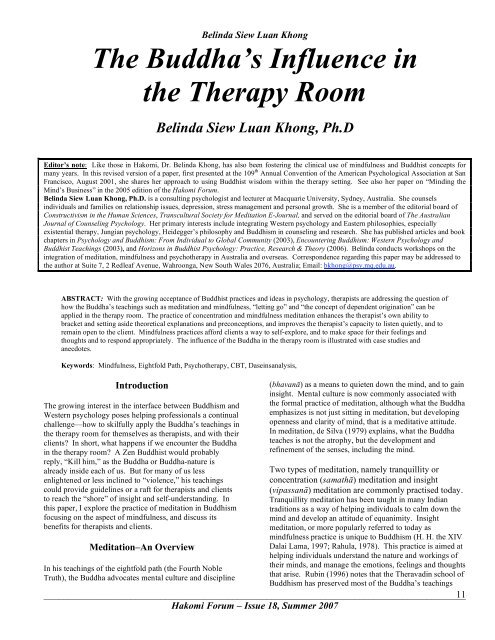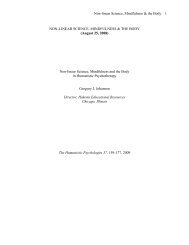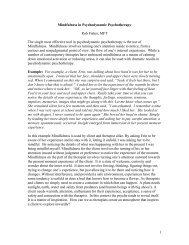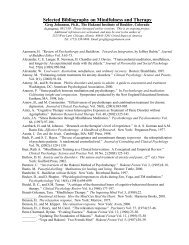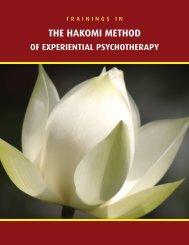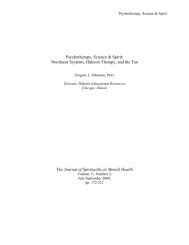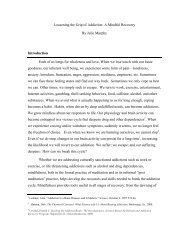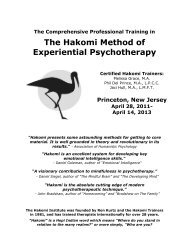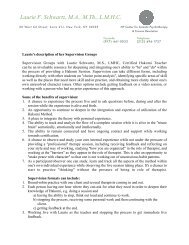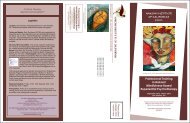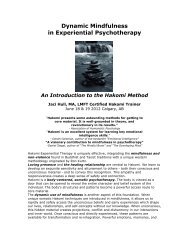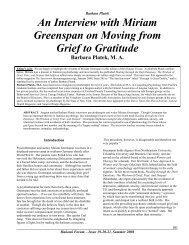The Buddha's Influence in the Therapy Room - Hakomi Institute
The Buddha's Influence in the Therapy Room - Hakomi Institute
The Buddha's Influence in the Therapy Room - Hakomi Institute
You also want an ePaper? Increase the reach of your titles
YUMPU automatically turns print PDFs into web optimized ePapers that Google loves.
Bel<strong>in</strong>da Siew Luan Khong<br />
<strong>The</strong> Buddha’s <strong>Influence</strong> <strong>in</strong><br />
<strong>the</strong> <strong>The</strong>rapy <strong>Room</strong><br />
Bel<strong>in</strong>da Siew Luan Khong, Ph.D<br />
Editor’s note: Like those <strong>in</strong> <strong>Hakomi</strong>, Dr. Bel<strong>in</strong>da Khong, has also been foster<strong>in</strong>g <strong>the</strong> cl<strong>in</strong>ical use of m<strong>in</strong>dfulness and Buddhist concepts for<br />
many years. In this revised version of a paper, first presented at <strong>the</strong> 109 th Annual Convention of <strong>the</strong> American Psychological Association at San<br />
Francisco, August 2001, she shares her approach to us<strong>in</strong>g Buddhist wisdom with<strong>in</strong> <strong>the</strong> <strong>the</strong>rapy sett<strong>in</strong>g. See also her paper on “M<strong>in</strong>d<strong>in</strong>g <strong>the</strong><br />
M<strong>in</strong>d’s Bus<strong>in</strong>ess” <strong>in</strong> <strong>the</strong> 2005 edition of <strong>the</strong> <strong>Hakomi</strong> Forum.<br />
Bel<strong>in</strong>da Siew Luan Khong, Ph.D. is a consult<strong>in</strong>g psychologist and lecturer at Macquarie University, Sydney, Australia. She counsels<br />
<strong>in</strong>dividuals and families on relationship issues, depression, stress management and personal growth. She is a member of <strong>the</strong> editorial board of<br />
Constructivism <strong>in</strong> <strong>the</strong> Human Sciences, Transcultural Society for Meditation E-Journal, and served on <strong>the</strong> editorial board of <strong>The</strong> Australian<br />
Journal of Counsel<strong>in</strong>g Psychology. Her primary <strong>in</strong>terests <strong>in</strong>clude <strong>in</strong>tegrat<strong>in</strong>g Western psychology and Eastern philosophies, especially<br />
existential <strong>the</strong>rapy, Jungian psychology, Heidegger’s philosophy and Buddhism <strong>in</strong> counsel<strong>in</strong>g and research. She has published articles and book<br />
chapters <strong>in</strong> Psychology and Buddhism: From Individual to Global Community (2003), Encounter<strong>in</strong>g Buddhism: Western Psychology and<br />
Buddhist Teach<strong>in</strong>gs (2003), and Horizons <strong>in</strong> Buddhist Psychology: Practice, Research & <strong>The</strong>ory (2006). Bel<strong>in</strong>da conducts workshops on <strong>the</strong><br />
<strong>in</strong>tegration of meditation, m<strong>in</strong>dfulness and psycho<strong>the</strong>rapy <strong>in</strong> Australia and overseas. Correspondence regard<strong>in</strong>g this paper may be addressed to<br />
<strong>the</strong> author at Suite 7, 2 Redleaf Avenue, Wahroonga, New South Wales 2076, Australia; Email: bkhong@psy.mq.edu.au.<br />
ABSTRACT: With <strong>the</strong> grow<strong>in</strong>g acceptance of Buddhist practices and ideas <strong>in</strong> psychology, <strong>the</strong>rapists are address<strong>in</strong>g <strong>the</strong> question of<br />
how <strong>the</strong> Buddha’s teach<strong>in</strong>gs such as meditation and m<strong>in</strong>dfulness, “lett<strong>in</strong>g go” and “<strong>the</strong> concept of dependent orig<strong>in</strong>ation” can be<br />
applied <strong>in</strong> <strong>the</strong> <strong>the</strong>rapy room. <strong>The</strong> practice of concentration and m<strong>in</strong>dfulness meditation enhances <strong>the</strong> <strong>the</strong>rapist’s own ability to<br />
bracket and sett<strong>in</strong>g aside <strong>the</strong>oretical explanations and preconceptions, and improves <strong>the</strong> <strong>the</strong>rapist’s capacity to listen quietly, and to<br />
rema<strong>in</strong> open to <strong>the</strong> client. M<strong>in</strong>dfulness practices afford clients a way to self-explore, and to make space for <strong>the</strong>ir feel<strong>in</strong>gs and<br />
thoughts and to respond appropriately. <strong>The</strong> <strong>in</strong>fluence of <strong>the</strong> Buddha <strong>in</strong> <strong>the</strong> <strong>the</strong>rapy room is illustrated with case studies and<br />
anecdotes.<br />
Keywords: M<strong>in</strong>dfulness, Eightfold Path, Psycho<strong>the</strong>rapy, CBT, Dase<strong>in</strong>sanalysis,<br />
Introduction<br />
<strong>The</strong> grow<strong>in</strong>g <strong>in</strong>terest <strong>in</strong> <strong>the</strong> <strong>in</strong>terface between Buddhism and<br />
Western psychology poses help<strong>in</strong>g professionals a cont<strong>in</strong>ual<br />
challenge—how to skilfully apply <strong>the</strong> Buddha’s teach<strong>in</strong>gs <strong>in</strong><br />
<strong>the</strong> <strong>the</strong>rapy room for <strong>the</strong>mselves as <strong>the</strong>rapists, and with <strong>the</strong>ir<br />
clients? In short, what happens if we encounter <strong>the</strong> Buddha<br />
<strong>in</strong> <strong>the</strong> <strong>the</strong>rapy room? A Zen Buddhist would probably<br />
reply, “Kill him,” as <strong>the</strong> Buddha or Buddha-nature is<br />
already <strong>in</strong>side each of us. But for many of us less<br />
enlightened or less <strong>in</strong>cl<strong>in</strong>ed to “violence,” his teach<strong>in</strong>gs<br />
could provide guidel<strong>in</strong>es or a raft for <strong>the</strong>rapists and clients<br />
to reach <strong>the</strong> “shore” of <strong>in</strong>sight and self-understand<strong>in</strong>g. In<br />
this paper, I explore <strong>the</strong> practice of meditation <strong>in</strong> Buddhism<br />
focus<strong>in</strong>g on <strong>the</strong> aspect of m<strong>in</strong>dfulness, and discuss its<br />
benefits for <strong>the</strong>rapists and clients.<br />
Meditation–An Overview<br />
In his teach<strong>in</strong>gs of <strong>the</strong> eightfold path (<strong>the</strong> Fourth Noble<br />
Truth), <strong>the</strong> Buddha advocates mental culture and discipl<strong>in</strong>e<br />
(bhavanā) as a means to quieten down <strong>the</strong> m<strong>in</strong>d, and to ga<strong>in</strong><br />
<strong>in</strong>sight. Mental culture is now commonly associated with<br />
<strong>the</strong> formal practice of meditation, although what <strong>the</strong> Buddha<br />
emphasizes is not just sitt<strong>in</strong>g <strong>in</strong> meditation, but develop<strong>in</strong>g<br />
openness and clarity of m<strong>in</strong>d, that is a meditative attitude.<br />
In meditation, de Silva (1979) expla<strong>in</strong>s, what <strong>the</strong> Buddha<br />
teaches is not <strong>the</strong> atrophy, but <strong>the</strong> development and<br />
ref<strong>in</strong>ement of <strong>the</strong> senses, <strong>in</strong>clud<strong>in</strong>g <strong>the</strong> m<strong>in</strong>d.<br />
Two types of meditation, namely tranquillity or<br />
concentration (samathā) meditation and <strong>in</strong>sight<br />
(vipassanā) meditation are commonly practised today.<br />
Tranquillity meditation has been taught <strong>in</strong> many Indian<br />
traditions as a way of help<strong>in</strong>g <strong>in</strong>dividuals to calm down <strong>the</strong><br />
m<strong>in</strong>d and develop an attitude of equanimity. Insight<br />
meditation, or more popularly referred to today as<br />
m<strong>in</strong>dfulness practice is unique to Buddhism (H. H. <strong>the</strong> XIV<br />
Dalai Lama, 1997; Rahula, 1978). This practice is aimed at<br />
help<strong>in</strong>g <strong>in</strong>dividuals understand <strong>the</strong> nature and work<strong>in</strong>gs of<br />
<strong>the</strong>ir m<strong>in</strong>ds, and manage <strong>the</strong> emotions, feel<strong>in</strong>gs and thoughts<br />
that arise. Rub<strong>in</strong> (1996) notes that <strong>the</strong> <strong>The</strong>ravad<strong>in</strong> school of<br />
Buddhism has preserved most of <strong>the</strong> Buddha’s teach<strong>in</strong>gs<br />
_______________________________________________________________________________________ 11<br />
<strong>Hakomi</strong> Forum – Issue 18, Summer 2007
elat<strong>in</strong>g to meditation and my discussion centres on <strong>the</strong><br />
practices of this school.<br />
In <strong>the</strong> eightfold path, right effort, right concentration, and<br />
right m<strong>in</strong>dfulness are promoted as important factors <strong>in</strong><br />
meditation. Of <strong>the</strong> three, right m<strong>in</strong>dfulness is regarded as<br />
<strong>the</strong> most critical factor for as Nyanaponika (1992) expla<strong>in</strong>s,<br />
m<strong>in</strong>dfulness is “<strong>the</strong> heart of Buddhist meditation.”<br />
Bel<strong>in</strong>da Siew Luan Khong<br />
<strong>The</strong> Buddhist practice of m<strong>in</strong>dfulness is based on <strong>the</strong> four<br />
foundations of m<strong>in</strong>dfulness (satipatthāna), that is<br />
ma<strong>in</strong>ta<strong>in</strong><strong>in</strong>g cont<strong>in</strong>uous awareness of (1) <strong>the</strong> body (e.g. <strong>the</strong><br />
breath, posture, bodily sensations etc) (2) feel<strong>in</strong>gs (whe<strong>the</strong>r<br />
pleasant, unpleasant, or neutral) (3) states of m<strong>in</strong>d (e.g.<br />
depressed, anxious , angry and so forth) and (4) <strong>the</strong> mental<br />
contents (<strong>the</strong> objects or thoughts occupy<strong>in</strong>g <strong>the</strong> m<strong>in</strong>d at a<br />
given moment) (Nyanaponika, 1992; Goleman, 1984).<br />
Briefly, right concentration <strong>in</strong>volves focus<strong>in</strong>g <strong>the</strong> m<strong>in</strong>d on<br />
one stimulus, such as <strong>the</strong> breath, mantra, lov<strong>in</strong>g k<strong>in</strong>dness,<br />
chant<strong>in</strong>g etc., (<strong>the</strong> objects of meditation) to <strong>the</strong> exclusion of<br />
o<strong>the</strong>r stimuli. Right effort refers to <strong>the</strong> application of <strong>the</strong><br />
right amount of effort to susta<strong>in</strong> this concentration, and to<br />
prevent negative (unwholesome) thoughts from <strong>in</strong>trud<strong>in</strong>g.<br />
By enabl<strong>in</strong>g <strong>the</strong> m<strong>in</strong>d to stay focused, this practice of “onepo<strong>in</strong>tedness”<br />
reduces <strong>the</strong> m<strong>in</strong>d’s tendency to rum<strong>in</strong>ate and<br />
become distracted. While tranquillity meditation focuses<br />
ma<strong>in</strong>ly on <strong>the</strong> cultivation of right concentration, <strong>in</strong>sight<br />
meditation emphasizes <strong>the</strong> cultivation of right m<strong>in</strong>dfulness<br />
and observation (Rahula, 1978).<br />
What is right m<strong>in</strong>dfulness? Accord<strong>in</strong>g to Germer (2005),<br />
<strong>the</strong> term m<strong>in</strong>dfulness can be used “to describe a <strong>the</strong>oretical<br />
construct (m<strong>in</strong>dfulness), <strong>the</strong> practice of cultivat<strong>in</strong>g<br />
m<strong>in</strong>dfulness (such as meditation) or a psychological process<br />
(be<strong>in</strong>g m<strong>in</strong>dful)” (p. 6). In this article, <strong>the</strong> word<br />
m<strong>in</strong>dfulness is used <strong>in</strong> <strong>the</strong> last two ways described by<br />
Germer. <strong>The</strong>re are many facets and benefits of m<strong>in</strong>dfulness<br />
practice, and <strong>in</strong> my discussion, I emphasize <strong>the</strong> aspects that<br />
are particularly relevant and useful for <strong>the</strong>rapy.<br />
Different explanations have been given to capture <strong>the</strong><br />
essence of m<strong>in</strong>dfulness, and what is <strong>in</strong>volved <strong>in</strong> be<strong>in</strong>g<br />
m<strong>in</strong>dful. Gunaratana (1991, p. 148) expla<strong>in</strong>s that<br />
m<strong>in</strong>dfulness <strong>in</strong>volves “<strong>the</strong> ability to see th<strong>in</strong>gs as <strong>the</strong>y really<br />
are … to give bare attention, and just look<strong>in</strong>g at whatever<br />
comes up <strong>in</strong> <strong>the</strong> m<strong>in</strong>d, or <strong>in</strong> each situation as it occurs.”<br />
M<strong>in</strong>dfulness, accord<strong>in</strong>g to Kabat-Z<strong>in</strong>n (1994), “means<br />
pay<strong>in</strong>g attention <strong>in</strong> a particular way: on purpose, <strong>in</strong> <strong>the</strong><br />
present moment and non-judgementally. This k<strong>in</strong>d of<br />
attention nurtures greater awareness, clarity and acceptance<br />
of present-moment reality” (p. 4). In a comprehensive<br />
article on <strong>The</strong> Use of M<strong>in</strong>dfulness <strong>in</strong> Psycho<strong>the</strong>rapy,<br />
Johanson (2006) notes that “a m<strong>in</strong>dful state of<br />
consciousness is characterized by awareness turned <strong>in</strong>ward<br />
towards present felt experience. It is passive, though alert,<br />
open, curious and exploratory. It seeks to simply be aware<br />
of what is, as opposed to attempt<strong>in</strong>g to do or confirm<br />
anyth<strong>in</strong>g” (p. 24).<br />
Although m<strong>in</strong>dfulness is a capacity that we all possess, yet<br />
be<strong>in</strong>g m<strong>in</strong>dful and pay<strong>in</strong>g attention to our current<br />
experiences is not an easy task as we tend to <strong>in</strong>fuse what we<br />
perceive with self-<strong>in</strong>terests and subjective judgements. <strong>The</strong><br />
task of bare attention, as Gunaratana notes, is to elim<strong>in</strong>ate<br />
all <strong>the</strong>se accretions to <strong>the</strong> object proper.<br />
In its role as pure awareness, m<strong>in</strong>dfulness allows meditators<br />
to freely observe what <strong>the</strong>y perceive and experience without<br />
need<strong>in</strong>g to change, justify or repress it. Take <strong>the</strong> example of<br />
anger. Rahula (1978) expla<strong>in</strong>s that be<strong>in</strong>g m<strong>in</strong>dful means<br />
becom<strong>in</strong>g aware of <strong>the</strong> state of m<strong>in</strong>d as an angry m<strong>in</strong>d, and<br />
watch<strong>in</strong>g this state objectively, how <strong>the</strong> feel<strong>in</strong>g of anger<br />
arises and dissipates if we do not become attached to <strong>the</strong><br />
feel<strong>in</strong>g. M<strong>in</strong>dfulness <strong>in</strong>creases awareness of <strong>the</strong> circuitous<br />
nature of <strong>the</strong> m<strong>in</strong>d as expounded <strong>in</strong> <strong>the</strong> Buddha’s teach<strong>in</strong>gs<br />
of dependent orig<strong>in</strong>ation or <strong>in</strong>ter-relatedness (i.e., how one<br />
th<strong>in</strong>g leads to ano<strong>the</strong>r) and karma (cause and effect).<br />
Additionally, m<strong>in</strong>dfulness encourages practitioners to<br />
acknowledge and accept what is <strong>the</strong>re. By simply observ<strong>in</strong>g<br />
our thoughts and emotions as <strong>the</strong>y arise, and labell<strong>in</strong>g <strong>the</strong>m<br />
objectively (e.g. anger as anger; pa<strong>in</strong> as pa<strong>in</strong>) we uncover<br />
strengths and weakness that have hi<strong>the</strong>rto rema<strong>in</strong>ed covered<br />
and learn to deal with <strong>the</strong>m. <strong>The</strong> practice of just labell<strong>in</strong>g,<br />
acknowledg<strong>in</strong>g and experienc<strong>in</strong>g <strong>the</strong> feel<strong>in</strong>g without<br />
necessarily hav<strong>in</strong>g to express it has significant <strong>the</strong>rapeutic<br />
benefits (Khong, 2005).<br />
In order to be m<strong>in</strong>dful, it is important to learn to listen<br />
quietly. <strong>The</strong> ord<strong>in</strong>ary m<strong>in</strong>d is constantly rum<strong>in</strong>at<strong>in</strong>g,<br />
carry<strong>in</strong>g on an <strong>in</strong>ternal dialogue. For example, many of us<br />
are busy th<strong>in</strong>k<strong>in</strong>g of our own responses as we are listen<strong>in</strong>g<br />
to <strong>the</strong> speaker. <strong>The</strong> practice of concentration and<br />
m<strong>in</strong>dfulness enables us to “see” <strong>the</strong> work<strong>in</strong>gs of our m<strong>in</strong>ds<br />
without add<strong>in</strong>g associative value to what is be<strong>in</strong>g actually<br />
enunciated. This is a useful skill for <strong>the</strong>rapists to cultivate.<br />
For <strong>the</strong> <strong>The</strong>rapist<br />
<strong>The</strong> practice of m<strong>in</strong>dfulness is helpful to <strong>the</strong> <strong>the</strong>rapist <strong>in</strong><br />
numerous ways. Here I focus on <strong>the</strong> contributions that<br />
m<strong>in</strong>dfulness can make to <strong>the</strong> attitude of <strong>the</strong> <strong>the</strong>rapist when<br />
<strong>in</strong>teract<strong>in</strong>g with clients. In psychoanalysis, Freud (1912)<br />
recommends <strong>the</strong>rapists adopt an attitude of “evenlysuspended<br />
attention” (p. 111) towards clients. Accord<strong>in</strong>g to<br />
Freud, this attitude, which behoves <strong>the</strong> <strong>the</strong>rapist “to give<br />
equal notice to everyth<strong>in</strong>g,” and to “simply listen” (p. 112)<br />
to <strong>the</strong> client, encourages <strong>the</strong> client to freely associate<br />
without concern with censorship. Boss (1984-1985) <strong>the</strong><br />
founder of dase<strong>in</strong>sanalysis, or existential analysis, refers to<br />
this k<strong>in</strong>d of attitude as “constant attentiveness” (p. 122), and<br />
adds that such an attitude enables <strong>the</strong> <strong>the</strong>rapist to hear<br />
beyond what is be<strong>in</strong>g verbalised. To acquire this stance,<br />
Boss notes that <strong>the</strong> <strong>the</strong>rapist’s existence must be more open<br />
and expansive than that of <strong>the</strong> patient.<br />
_______________________________________________________________________________________<br />
12<br />
<strong>Hakomi</strong> Forum – Issue 18, Summer 2007
<strong>The</strong>se are laudable recommendations for <strong>the</strong>rapists, and<br />
most <strong>the</strong>rapists do that to a large extent. However, <strong>the</strong>re is a<br />
significant, albeit subtle difference between <strong>the</strong> k<strong>in</strong>d of open<br />
attitude advocated <strong>in</strong> psycho<strong>the</strong>rapy and <strong>the</strong> attitude<br />
promoted <strong>in</strong> Buddhist m<strong>in</strong>dfulness. <strong>The</strong> stance advanced by<br />
people like Freud and Boss is <strong>in</strong>tended to facilitate <strong>the</strong><br />
<strong>the</strong>rapist’s attentiveness to clients’ experiences and state of<br />
m<strong>in</strong>d. While Buddhist m<strong>in</strong>dfulness promotes a similar<br />
attitude towards clients’ experiences, it goes fur<strong>the</strong>r than<br />
that. M<strong>in</strong>dfulness makes it possible for <strong>the</strong>rapists to listen<br />
not only to <strong>the</strong> client, but also to <strong>the</strong>ir own state of m<strong>in</strong>d –<br />
that is to be constantly aware of <strong>the</strong> murmur<strong>in</strong>gs <strong>in</strong> <strong>the</strong>ir<br />
m<strong>in</strong>ds and not allow this <strong>in</strong>ternal dialogue to impede <strong>the</strong>ir<br />
openness. As Nyanaponika (1992) puts it “one who is<br />
m<strong>in</strong>dful will first m<strong>in</strong>d his own m<strong>in</strong>d’s bus<strong>in</strong>ess” (p. 81). In<br />
short, m<strong>in</strong>dfulness asks of <strong>the</strong>rapists noth<strong>in</strong>g more than to<br />
just wait and listen quietly both to his own dialogue and <strong>the</strong><br />
dialogue of <strong>the</strong> client.<br />
But how do we bracket conceptualis<strong>in</strong>g and just listen? As I<br />
noted earlier, <strong>the</strong> ord<strong>in</strong>ary m<strong>in</strong>d is constantly chatter<strong>in</strong>g and<br />
rum<strong>in</strong>at<strong>in</strong>g. No matter how rigorously people wish to<br />
suspend <strong>the</strong>ir bias, judgements and preconceptions, and to<br />
rema<strong>in</strong> open, if <strong>the</strong> bracket<strong>in</strong>g is affected <strong>in</strong>tellectually (as<br />
opposed to experientially) it has its limitations.<br />
Batchelor (1990) expla<strong>in</strong>s that <strong>the</strong> meditative attitude does<br />
not rely on any formal method to susta<strong>in</strong> itself. He adds<br />
however, that if that k<strong>in</strong>d of silence eludes us, it is helpful to<br />
adopt methods that can help us cultivate this attitude.<br />
Concentration and m<strong>in</strong>dfulness practices equip <strong>the</strong> <strong>the</strong>rapist<br />
with <strong>the</strong> skills and mental discipl<strong>in</strong>e to quieten <strong>the</strong> m<strong>in</strong>d and<br />
to focus. In psycho<strong>the</strong>rapy, <strong>the</strong> means of help<strong>in</strong>g <strong>the</strong>rapists<br />
to cultivate this k<strong>in</strong>d of attitude is currently lack<strong>in</strong>g.<br />
Accord<strong>in</strong>g to Fulton (2005) and Epste<strong>in</strong> (2003), one of <strong>the</strong><br />
benefits to <strong>the</strong>rapists and physicians <strong>in</strong> be<strong>in</strong>g m<strong>in</strong>dful is an<br />
<strong>in</strong>creased tolerance for what Fulton describes as “learn<strong>in</strong>g<br />
not to know” (p. 70) and Epste<strong>in</strong> calls cultivat<strong>in</strong>g a<br />
“beg<strong>in</strong>ner’s m<strong>in</strong>d” (p. 17) when <strong>in</strong>teract<strong>in</strong>g with clients.<br />
Fulton and Epste<strong>in</strong> aver that this k<strong>in</strong>d of open-m<strong>in</strong>dedness<br />
allows health-care professionals to learn to accept<br />
uncerta<strong>in</strong>ty, see each situation afresh, set aside preconceived<br />
notions and <strong>the</strong>ories about clients’ problems, and “cures,”<br />
and respond appropriately to <strong>the</strong> demands of each moment.<br />
Bel<strong>in</strong>da Siew Luan Khong<br />
without any impact from you. Like I am not changed<br />
by be<strong>in</strong>g <strong>in</strong> <strong>the</strong>re.<br />
By sitt<strong>in</strong>g with Carol<strong>in</strong>e “without an agenda” but more<br />
importantly ma<strong>in</strong>ta<strong>in</strong><strong>in</strong>g moment-to-moment awareness of<br />
her, and my own, state of m<strong>in</strong>d, I am better able to be <strong>the</strong>re<br />
with her ra<strong>the</strong>r than just be<strong>in</strong>g <strong>the</strong>re for her.<br />
For <strong>the</strong> Client<br />
In <strong>the</strong> previous section, I discussed <strong>the</strong> usefulness of<br />
m<strong>in</strong>dfulness for <strong>the</strong>rapists and for <strong>the</strong> <strong>the</strong>rapeutic<br />
relationship. M<strong>in</strong>dfulness is also beneficial to clients <strong>in</strong> and<br />
outside of <strong>the</strong> <strong>the</strong>rapy room.<br />
M<strong>in</strong>dfulness practice does not require <strong>the</strong> empty<strong>in</strong>g of <strong>the</strong><br />
m<strong>in</strong>d or <strong>the</strong> sett<strong>in</strong>g aside or suppression of thoughts. Ra<strong>the</strong>r<br />
it permits us to be constantly aware of <strong>the</strong> work<strong>in</strong>gs and <strong>the</strong><br />
contents of <strong>the</strong> m<strong>in</strong>d so as not to allow <strong>the</strong>m to <strong>in</strong>terfere<br />
with our ability to listen quietly. <strong>The</strong> Buddha encourages<br />
people to experience for <strong>the</strong>mselves <strong>the</strong> tendency of <strong>the</strong><br />
m<strong>in</strong>d to wander. Understand<strong>in</strong>g this process, <strong>in</strong>dividuals<br />
have <strong>the</strong> choice and <strong>the</strong> responsibility to <strong>in</strong>terrupt this<br />
process so that th<strong>in</strong>gs can be o<strong>the</strong>rwise. Jane, ano<strong>the</strong>r client,<br />
captured <strong>the</strong> essence of m<strong>in</strong>dfulness succ<strong>in</strong>ctly when she<br />
expla<strong>in</strong>ed that m<strong>in</strong>dfulness has enabled her to watch her<br />
thoughts and responses tak<strong>in</strong>g place <strong>in</strong> “real time” ra<strong>the</strong>r<br />
than from h<strong>in</strong>dsight.<br />
Accord<strong>in</strong>g to Kabat-Z<strong>in</strong>n (1994) m<strong>in</strong>dfulness is “simply a<br />
practical way to be more <strong>in</strong> touch with <strong>the</strong> fullness of your<br />
be<strong>in</strong>g through a systematic process of self-observation, self<strong>in</strong>quiry<br />
and m<strong>in</strong>dful action” (p. 6). In his teach<strong>in</strong>gs, <strong>the</strong><br />
Buddha promotes self-help through self-exploration. One of<br />
<strong>the</strong> benefits of this process is that clients can learn to isolate<br />
<strong>the</strong> issues for <strong>the</strong>mselves and <strong>the</strong>n deal with <strong>the</strong>m<br />
holistically with <strong>the</strong> help of <strong>the</strong> <strong>the</strong>rapist. In contrast, <strong>in</strong><br />
psycho<strong>the</strong>rapy, <strong>the</strong>rapists are often engaged with clients<br />
dur<strong>in</strong>g <strong>the</strong> process of exploration, help<strong>in</strong>g <strong>the</strong>m to isolate<br />
and resolve issues.<br />
Diana’s explanation of how m<strong>in</strong>dfulness practice helped her<br />
to ga<strong>in</strong> valuable <strong>in</strong>sights and pursue her own personal<br />
growth illustrates <strong>the</strong> value of this meditative process of<br />
self-observation and self-<strong>in</strong>quiry.<br />
Epste<strong>in</strong> (1995) expla<strong>in</strong>s that “when a <strong>the</strong>rapist can sit with a<br />
patient without an agenda . . . <strong>the</strong> <strong>the</strong>rapist is <strong>in</strong>fus<strong>in</strong>g <strong>the</strong><br />
<strong>the</strong>rapy with lessons of meditation. . . .<strong>The</strong> patient can feel<br />
such a posture” (p. 187). Carol<strong>in</strong>e, a client of m<strong>in</strong>e expla<strong>in</strong>s<br />
why she found this stance to be beneficial <strong>in</strong> our counsel<strong>in</strong>g<br />
(Khong, 2006).<br />
Because you have a clear space . . . <strong>in</strong>side of you<br />
where I can know that, that space is open, fill you with<br />
me I suppose. . . . But you personally, even though I<br />
fill that receptacle, or you have that openness for me,<br />
you are not <strong>the</strong>re. I mean I am <strong>the</strong>re. I can be <strong>the</strong>re<br />
Diana’s story<br />
Diana, an attractive professional <strong>in</strong> her late thirties, came to<br />
counsel<strong>in</strong>g to deal with her feel<strong>in</strong>gs of high anxiety, and her<br />
panic attacks. Counsel<strong>in</strong>g helped her to uncover<br />
developmental issues aris<strong>in</strong>g from her ambivalent<br />
relationship with her family dur<strong>in</strong>g her grow<strong>in</strong>g up years,<br />
which have also impacted negatively on her sense of self<br />
worth. I encouraged Diana to use m<strong>in</strong>dfulness to explore<br />
her feel<strong>in</strong>gs, thoughts and responses cont<strong>in</strong>uously and to<br />
br<strong>in</strong>g her <strong>in</strong>sights to counsel<strong>in</strong>g for us to look at <strong>the</strong>m<br />
_______________________________________________________________________________________ 13<br />
<strong>Hakomi</strong> Forum – Issue 18, Summer 2007
toge<strong>the</strong>r. With <strong>the</strong> complementary use of meditation,<br />
m<strong>in</strong>dfulness practice and <strong>the</strong>rapy, Diana was able to<br />
recognize, among o<strong>the</strong>r issues, <strong>the</strong> seductive powers of<br />
feel<strong>in</strong>g like a victim, and her strategy <strong>in</strong> us<strong>in</strong>g this construct<br />
to ga<strong>in</strong> external validation from o<strong>the</strong>r people. From <strong>the</strong>se<br />
<strong>in</strong>sights, Diana learned to change her negative attitude and<br />
to take responsibility for her life. I quote Diana’s<br />
explanation at length to demonstrate how m<strong>in</strong>dfulness<br />
helped her self-exploration and self-understand<strong>in</strong>g:<br />
I just feel more ease with stuff. I had a good week this<br />
week. <strong>The</strong> previous week was lousy. But I didn’t<br />
dwell on it, and it didn’t br<strong>in</strong>g me down, which I used<br />
to do <strong>in</strong> <strong>the</strong> past. I acknowledge that “I just feel like<br />
crap today, but it will get better. Just take care of<br />
yourself. Don’t try to be a hero. Or a victim. It took<br />
me a while to get <strong>in</strong>to <strong>the</strong> habit of that. Learn<strong>in</strong>g new<br />
skills. Acknowledg<strong>in</strong>g and lett<strong>in</strong>g it go. Instead of<br />
dwell<strong>in</strong>g on it. I realise that I would get it a bit, and<br />
<strong>the</strong>n I would lose it. Get <strong>in</strong>to old habits. But I would<br />
get back on <strong>the</strong> horse, and try aga<strong>in</strong>.<br />
Previously I didn’t believe enough that it [m<strong>in</strong>dfulness<br />
practice] would have such a change, such an effect. I<br />
also recognized <strong>the</strong> power of negativeness. It was so<br />
strong <strong>in</strong> me, that it would always draw me back. I<br />
feel a victim as well. I realise that now. I like be<strong>in</strong>g <strong>in</strong><br />
<strong>the</strong> victim mentality. My self esteem was so low at<br />
certa<strong>in</strong> po<strong>in</strong>ts. Be<strong>in</strong>g a victim gave me someth<strong>in</strong>g<br />
important to feel about. If someth<strong>in</strong>g bad happens to<br />
me, and I am a victim, “It’s like that is what I am. You<br />
know, give myself a label.” And <strong>the</strong>n people would<br />
look after me and be nice to me. I can get attention.<br />
Aga<strong>in</strong> it is a lazy way of k<strong>in</strong>d of, to get attention. . . . I<br />
was wait<strong>in</strong>g for <strong>the</strong>m to come to me. <strong>The</strong>y have to<br />
make <strong>the</strong> effort because I am a victim, and I can’t do<br />
that. Like support me and help me. Feed me mentally.<br />
Because I can’t do anyth<strong>in</strong>g. I don’t do that anymore.<br />
It not just <strong>the</strong> sitt<strong>in</strong>g meditation. Meditation helps me<br />
to be calmer. It is more <strong>the</strong> m<strong>in</strong>dfulness. It is <strong>the</strong> one<br />
that works for me. Allows me to take me outside<br />
myself, and to th<strong>in</strong>k of o<strong>the</strong>rs. I f<strong>in</strong>d that helpful. It<br />
does get easier, <strong>the</strong> longer you are m<strong>in</strong>dful. Now I<br />
don’t see myself as all better or bad. It is just who you<br />
are. But I know now what my negative tendencies are.<br />
I can to recognize <strong>the</strong>m now. Before I never used to.<br />
M<strong>in</strong>dfulness really helped me not only to see that, but<br />
also <strong>the</strong>n not go down that direction, dwell<strong>in</strong>g on<br />
th<strong>in</strong>gs, and do<strong>in</strong>g a vicious circle th<strong>in</strong>g. Now I say,<br />
“Ok, that’s it, let’s not th<strong>in</strong>k about that, or not go down<br />
that road. And move on.” I just let it go and move on.<br />
That has been really helpful.<br />
I th<strong>in</strong>k that <strong>the</strong> o<strong>the</strong>r th<strong>in</strong>g is mak<strong>in</strong>g <strong>the</strong> decision to<br />
take responsibility. That is a big th<strong>in</strong>g for me. I didn’t<br />
want to take responsibility. I th<strong>in</strong>k that is where I fell<br />
down a lot of <strong>the</strong> time. I didn’t want to grow up and<br />
take responsibility to be an adult, and say that is all<br />
done now, and move on. To take responsibility for my<br />
life. It is quite hard to do that. But when you are not<br />
do<strong>in</strong>g it, not tak<strong>in</strong>g responsibility, that is quite hard to<br />
do as well [laughter].<br />
Bel<strong>in</strong>da Siew Luan Khong<br />
As Diana’s explanation shows, m<strong>in</strong>dfulness not only<br />
enables her to step outside herself and make an honest and<br />
objective appraisal of her limitations, it also affords her <strong>the</strong><br />
courage to confront and tolerate <strong>the</strong> “brutal” conclusions she<br />
reached, and to let go. Her relationship with her family and<br />
partner has improved significantly. Recently, Diana<br />
developed a tax<strong>in</strong>g medical condition, but found that she<br />
was able to manage it better with her change of attitude.<br />
<strong>The</strong> Buddha’s Teach<strong>in</strong>gs<br />
and Psycho<strong>the</strong>rapy<br />
In this section, I explore some of <strong>the</strong> parallels and<br />
differences between <strong>the</strong> Buddhist meditative practices and<br />
psycho<strong>the</strong>rapy, and discuss how <strong>the</strong>se similarities and<br />
differences can be employed <strong>in</strong> <strong>the</strong> <strong>the</strong>rapy room. My<br />
discussion will focus on cognitive-behavioural <strong>the</strong>rapy<br />
(CBT), rational-emotive-behaviour <strong>the</strong>rapy (REBT), both of<br />
which promote <strong>the</strong> modification of behaviour and cognition,<br />
and dase<strong>in</strong>sanalysis, an existential <strong>the</strong>rapeutic approach that<br />
encourages “phenomenological see<strong>in</strong>g,” and “releasement”<br />
or “lett<strong>in</strong>g be”(Boss, 1963,1979).<br />
Briefly, <strong>the</strong> aim of CBT is to change irrational th<strong>in</strong>k<strong>in</strong>g <strong>in</strong>to<br />
more rational th<strong>in</strong>k<strong>in</strong>g (Burns, 1980; Rapee 1998).<br />
Accord<strong>in</strong>g to Kwee and Ellis (2001) REBT is concerned<br />
with chang<strong>in</strong>g irrational cognitions <strong>in</strong>to more rational ones<br />
“through a process of <strong>in</strong>ternal dialogue and through<br />
chang<strong>in</strong>g one’s feel<strong>in</strong>gs and behaviours” (p. 13.) This<br />
accords with <strong>the</strong> Buddhist approach of understand<strong>in</strong>g <strong>the</strong><br />
work<strong>in</strong>gs of <strong>the</strong> m<strong>in</strong>d, and replac<strong>in</strong>g negative thoughts and<br />
emotions with more positive ones.<br />
<strong>The</strong> concept of “phenomenological see<strong>in</strong>g” (Heidegger,<br />
1927/1962, p. 78) is used by Mart<strong>in</strong> Heidegger, <strong>the</strong> German<br />
philosopher, to describe an approach of permitt<strong>in</strong>g<br />
phenomena to unfold on <strong>the</strong>ir own terms. Follow<strong>in</strong>g<br />
Heidegger, Boss (1963, 1979) <strong>in</strong>corporated <strong>the</strong><br />
phenomenological method of see<strong>in</strong>g <strong>in</strong> dase<strong>in</strong>sanalysis.<br />
Accord<strong>in</strong>g to Boss, dase<strong>in</strong>sanalysis is a way of th<strong>in</strong>k<strong>in</strong>g that<br />
encourages <strong>the</strong>rapists to understand phenomena as <strong>the</strong>y are<br />
immediately perceived and experienced by clients. He<br />
expla<strong>in</strong>s that by adopt<strong>in</strong>g <strong>the</strong> phenomenological approach,<br />
<strong>the</strong> <strong>the</strong>rapist rema<strong>in</strong>s open to <strong>the</strong> client’s actual experiences,<br />
ra<strong>the</strong>r than attempt to <strong>in</strong>terpret <strong>the</strong>m <strong>in</strong> terms of scientific<br />
<strong>the</strong>ory or past causal relationships. In <strong>the</strong>ir book, Grace<br />
Unfold<strong>in</strong>g (1991), Johanson and Kurtz explore <strong>the</strong> practice<br />
of psycho<strong>the</strong>rapy <strong>in</strong> <strong>the</strong> spirit of Taoist philosophy and<br />
recommend that <strong>the</strong>rapists adopt an attitude of “non-do<strong>in</strong>g”<br />
(p. 9) as promoted by <strong>the</strong> Taoist sage, Lao Tzu. By nondo<strong>in</strong>g,<br />
Johanson and Kurtz expla<strong>in</strong>, <strong>the</strong> sage, or <strong>in</strong> this case<br />
<strong>the</strong> <strong>the</strong>rapist, simply attends to, and accommodates what<br />
comes up spontaneously <strong>in</strong> <strong>the</strong> client’s experience. In this<br />
way, accord<strong>in</strong>g to Johanson and Kurtz, clients are<br />
empowered and “can move on <strong>in</strong> a way that does not depend<br />
on <strong>the</strong> <strong>the</strong>rapist’s cleverness or <strong>in</strong>sight” (p. 10.)<br />
_______________________________________________________________________________________<br />
14<br />
<strong>Hakomi</strong> Forum – Issue 18, Summer 2007
Boss also encourages clients to set aside <strong>the</strong>oretical th<strong>in</strong>k<strong>in</strong>g<br />
and adopt meditative th<strong>in</strong>k<strong>in</strong>g, that is adopt<strong>in</strong>g a stance that<br />
allow <strong>the</strong>ir experiences to unfold naturally. <strong>The</strong> stance<br />
adopted by Boss is <strong>in</strong>fluenced by Heidegger’s notion of<br />
releasement (Gelassenheit) (1959/1966), a concept that<br />
promotes adopt<strong>in</strong>g an attitude of “non –will<strong>in</strong>g” (p. 59) or<br />
wait<strong>in</strong>g. Wait<strong>in</strong>g accord<strong>in</strong>g to Heidegger, <strong>in</strong>volves do<strong>in</strong>g<br />
noth<strong>in</strong>g, becom<strong>in</strong>g more void, more empty but richer <strong>in</strong><br />
possibilities. But wait<strong>in</strong>g <strong>in</strong> this sense does not imply<br />
<strong>in</strong>activity or <strong>in</strong>difference, for <strong>the</strong> released person is not<br />
<strong>in</strong>active, just open to different possibilities. Accord<strong>in</strong>g to<br />
Heidegger “releasement towards th<strong>in</strong>gs and openness to <strong>the</strong><br />
mystery never happens of <strong>the</strong>mselves. . . . Both flourish<br />
only through persistent, courageous th<strong>in</strong>k<strong>in</strong>g (p. 56, italics<br />
added.) Hence, releasement for Heidegger <strong>in</strong>volves both<br />
action and non-<strong>in</strong>terference depend<strong>in</strong>g on what is<br />
appropriate to <strong>the</strong> situation. In this respect, <strong>the</strong><br />
Heideggerian understand<strong>in</strong>g of releasement appears to<br />
reflect <strong>the</strong> Taoist notion of “wu-wei” which is best<br />
understood as action through non-action (Khong &<br />
Thompson, 1997).<br />
Like Heidegger, Boss sees releasement or lett<strong>in</strong>g be as<br />
<strong>in</strong>volv<strong>in</strong>g <strong>the</strong> exercise of “fundamental th<strong>in</strong>k<strong>in</strong>g . . . open<strong>in</strong>g<br />
your eyes so that all <strong>the</strong> mean<strong>in</strong>gfulness which makes up a<br />
certa<strong>in</strong> th<strong>in</strong>g may show itself to you” (quoted <strong>in</strong> Craig,<br />
1988). Boss’s suggestions appear to be <strong>in</strong> l<strong>in</strong>e with <strong>the</strong><br />
Buddha’s recommendation to see th<strong>in</strong>gs as <strong>the</strong>y are and to<br />
let <strong>the</strong>m be.<br />
<strong>The</strong> ma<strong>in</strong> difference between CBT, REBT and<br />
Dase<strong>in</strong>sanalysis, and <strong>the</strong> Buddhist approach is that <strong>the</strong>se<br />
<strong>the</strong>rapies tend to focus on utilis<strong>in</strong>g <strong>the</strong> <strong>in</strong>tellect to change<br />
cognitions while <strong>the</strong> Buddha emphasizes modify<strong>in</strong>g<br />
cognitions through experiential and attitud<strong>in</strong>al change.<br />
In my view, primarily us<strong>in</strong>g <strong>the</strong> <strong>in</strong>tellect to modify<br />
cognitions poses some <strong>in</strong>terest<strong>in</strong>g dilemmas. One of <strong>the</strong>se<br />
Bel<strong>in</strong>da Siew Luan Khong<br />
dilemmas is that while clients recognize <strong>the</strong> need to change<br />
<strong>the</strong>ir irrational cognitions <strong>in</strong>tellectually, <strong>the</strong>y are often<br />
unable to do so when <strong>the</strong>y are already feel<strong>in</strong>g negative,<br />
anxious or depressed. Ano<strong>the</strong>r dilemma is <strong>the</strong> “catch-22”<br />
position where<strong>in</strong> if clients’ th<strong>in</strong>k<strong>in</strong>g is irrational to some<br />
extent, <strong>the</strong>y may encounter considerable difficulty <strong>in</strong><br />
adopt<strong>in</strong>g an approach that calls largely for rational th<strong>in</strong>k<strong>in</strong>g<br />
or to learn to see th<strong>in</strong>gs phenomenologically. More<br />
importantly, how do clients cont<strong>in</strong>ue to “help” <strong>the</strong>mselves<br />
outside of <strong>the</strong> <strong>the</strong>rapy room?<br />
Many of <strong>the</strong>se dilemmas can be overcome by employ<strong>in</strong>g <strong>the</strong><br />
Buddhist meditative practices and <strong>the</strong> Buddha’s teach<strong>in</strong>gs<br />
appropriately. Let me illustrate with two cl<strong>in</strong>ical vignettes.<br />
Felicity’s story<br />
Felicity a young, attractive woman had a breakdown a few<br />
years ago and was diagnosed by her psychiatrist as suffer<strong>in</strong>g<br />
from paranoia. She had to discont<strong>in</strong>ue her higher education<br />
and was unable to work or socialise for any length of time.<br />
When she was referred to me, she presented with high<br />
anxiety, obsessive-compulsive disorder and depression.<br />
Felicity was constantly concerned with people follow<strong>in</strong>g<br />
her, be<strong>in</strong>g perceived as “normal,” and worried about hav<strong>in</strong>g<br />
ano<strong>the</strong>r breakdown.<br />
Dur<strong>in</strong>g counsel<strong>in</strong>g, I encouraged Felicity to learn to separate<br />
<strong>the</strong> situation from her feel<strong>in</strong>gs, <strong>in</strong>ternal dialogue and<br />
habitual responses. <strong>The</strong> outl<strong>in</strong>e <strong>in</strong> figure 1 is representative<br />
of <strong>the</strong> type of anxiety-provok<strong>in</strong>g situation, and <strong>the</strong> pattern of<br />
Felicity’s feel<strong>in</strong>gs, th<strong>in</strong>k<strong>in</strong>g and responses. Felicity’s<br />
anxiety often spiralled <strong>in</strong>to more and more negativity, and<br />
she would rum<strong>in</strong>ate cont<strong>in</strong>ually. She was unable to break<br />
<strong>the</strong> cycle, and wanted to learn to cope with her feel<strong>in</strong>gs of<br />
anxiety and depression.<br />
Situation Feel<strong>in</strong>gs Internal Dialogue Habitual Responses<br />
Attend<strong>in</strong>g a<br />
birthday party<br />
Anxiety “I’m stupid” Concerns with<br />
mak<strong>in</strong>g eye contact<br />
Fear<br />
“<strong>The</strong>y must th<strong>in</strong>k”<br />
I’m weird”<br />
Avoid social<br />
<strong>in</strong>teractions<br />
Tension<br />
“People are<br />
star<strong>in</strong>g at me”<br />
Emotionally shut<br />
down<br />
Depression<br />
Figure 1: Patterns of Felicity’s feel<strong>in</strong>gs, cognitions and habitual responses<br />
_______________________________________________________________________________________ 15<br />
<strong>Hakomi</strong> Forum – Issue 18, Summer 2007
Initially, Felicity was encouraged to try and change her<br />
irrational cognitions <strong>in</strong>to more rational ones, and to learn to<br />
see each situation phenomenologically. Although she found<br />
<strong>the</strong> comb<strong>in</strong>ation of CBT, REBT and dase<strong>in</strong>sanalytic<br />
approaches useful, she was unable to susta<strong>in</strong> this way of<br />
th<strong>in</strong>k<strong>in</strong>g for any length of time, especially outside <strong>the</strong>rapy.<br />
Bel<strong>in</strong>da Siew Luan Khong<br />
Additionally, because of her reactivity she was unable to<br />
stop her negative thoughts from spirall<strong>in</strong>g <strong>in</strong>to depression.<br />
Felicity was experienc<strong>in</strong>g many of <strong>the</strong> dilemmas described<br />
above. In counsel<strong>in</strong>g, by employ<strong>in</strong>g m<strong>in</strong>dfulness and<br />
various Buddhist ideas with Felicity, she experienced a<br />
breakthrough (see Figure 2).<br />
M<strong>in</strong>dfulness of<br />
bodily sensations<br />
Circuit<br />
breakers<br />
Pay<strong>in</strong>g bare attention<br />
(labell<strong>in</strong>g,<br />
acknowledg<strong>in</strong>g &<br />
experienc<strong>in</strong>g feel<strong>in</strong>gs)<br />
Internal<br />
dialogue /<br />
responses<br />
Heart rac<strong>in</strong>g<br />
Count<strong>in</strong>g <strong>the</strong><br />
breath<br />
“<strong>The</strong>re is anxiety”<br />
“I ‘m mak<strong>in</strong>g<br />
friends with my<br />
anxiety”<br />
Dryness <strong>in</strong> <strong>the</strong> throat Cook<strong>in</strong>g “I’m feel<strong>in</strong>g anxious” “I am feel<strong>in</strong>g<br />
anxious, not sick”<br />
“Just sit & experience<br />
<strong>the</strong> anxiety”<br />
Figure 2: Felicity—Application of m<strong>in</strong>dfulness practice<br />
Normally, when people are anxious or depressed, <strong>the</strong>y are<br />
unable to step out of this state of m<strong>in</strong>d and rema<strong>in</strong> trapped<br />
<strong>in</strong> a vicious circle whereby <strong>the</strong> negative th<strong>in</strong>k<strong>in</strong>g contributes<br />
to <strong>the</strong> negative mood, and <strong>the</strong> latter perpetuates <strong>the</strong> negative<br />
th<strong>in</strong>k<strong>in</strong>g. M<strong>in</strong>dfulness allows <strong>in</strong>dividuals to step out of <strong>the</strong>ir<br />
habitual pattern of th<strong>in</strong>k<strong>in</strong>g before it spiral <strong>in</strong>to more<br />
negativity.<br />
Utilis<strong>in</strong>g <strong>the</strong> Buddha’s teach<strong>in</strong>g of <strong>the</strong> four foundations of<br />
m<strong>in</strong>dfulness, Felicity was encouraged to be m<strong>in</strong>dful of her<br />
bodily sensations, thoughts and feel<strong>in</strong>gs whenever she starts<br />
to feel anxious. Felicity reported be<strong>in</strong>g aware of her heart<br />
rac<strong>in</strong>g and <strong>the</strong> dryness <strong>in</strong> her throat. She was also m<strong>in</strong>dful<br />
of her negative thoughts. Felicity was encouraged to put <strong>in</strong><br />
place various circuit breakers appropriate to her lifestyle.<br />
She used breath-count<strong>in</strong>g and cook<strong>in</strong>g, and learned to put<br />
<strong>the</strong>se circuit breakers <strong>in</strong> place at <strong>the</strong> time <strong>the</strong> bodily<br />
sensations were experienced ra<strong>the</strong>r than when <strong>the</strong> anxiety or<br />
rum<strong>in</strong>ative th<strong>in</strong>k<strong>in</strong>g had started. In this way, she was able,<br />
as <strong>the</strong> Buddha suggested, to disrupt <strong>the</strong> process so that<br />
th<strong>in</strong>gs could be o<strong>the</strong>rwise.<br />
Felicity was also encouraged to pay bare attention to<br />
whatever feel<strong>in</strong>g she was currently experienc<strong>in</strong>g without<br />
need<strong>in</strong>g to modify, repress or justify it. In this way, she was<br />
able to observe how her feel<strong>in</strong>g of anxiety led to fear, to<br />
tension, and ultimately to depression. She also learned to<br />
label each feel<strong>in</strong>g (e.g., anxiety as anxiety, fear as fear etc)<br />
as it arose, acknowledge and accept <strong>the</strong> feel<strong>in</strong>g by mak<strong>in</strong>g<br />
space for, ra<strong>the</strong>r than identify<strong>in</strong>g with it. I will elaborate<br />
more on this process when I discuss Carol<strong>in</strong>e’s case.<br />
reduce her rum<strong>in</strong>ation. <strong>The</strong>reafter she found it easier to<br />
change her <strong>in</strong>ternal dialogue and responses to more rational<br />
ones. More importantly, Felicity was able to susta<strong>in</strong> this<br />
way of th<strong>in</strong>k<strong>in</strong>g for longer periods, even outside of<br />
counsel<strong>in</strong>g<br />
Felicity expla<strong>in</strong>ed that be<strong>in</strong>g m<strong>in</strong>dful and us<strong>in</strong>g circuit<br />
breakers has helped her enormously. She reported feel<strong>in</strong>g<br />
stronger and happier, and that now <strong>in</strong>stead of rum<strong>in</strong>at<strong>in</strong>g for<br />
hours, she is able to let go of her anxiety and o<strong>the</strong>r negative<br />
thoughts <strong>in</strong> a few m<strong>in</strong>utes.<br />
It is because I allowed myself to feel <strong>the</strong> feel<strong>in</strong>gs. I<br />
don’t try to run away from it. I tell myself, “its ok.<br />
Just experience it.” For example, when I am feel<strong>in</strong>g<br />
anxious, I allow myself to just feel <strong>the</strong> anxiety. I ask<br />
myself where is <strong>the</strong> feel<strong>in</strong>g located, and give myself<br />
lov<strong>in</strong>g k<strong>in</strong>dness. I <strong>the</strong>n put <strong>in</strong> <strong>the</strong> circuit breakers. I just<br />
let <strong>the</strong> anxiety sit <strong>the</strong>re. I am becom<strong>in</strong>g friends with it<br />
now.<br />
Accord<strong>in</strong>g to Felicity, be<strong>in</strong>g friends with her feel<strong>in</strong>gs has<br />
made her more accept<strong>in</strong>g of herself and her state of m<strong>in</strong>d.<br />
I accept it for what I am. <strong>The</strong>re is just anxiety <strong>the</strong>re,<br />
and that’s how I am I have become more accept<strong>in</strong>g of<br />
myself, ra<strong>the</strong>r than say<strong>in</strong>g that I have a sickness and<br />
that it is mak<strong>in</strong>g me worse.<br />
Through counsel<strong>in</strong>g and <strong>the</strong> use of m<strong>in</strong>dfulness practice,<br />
Felicity was manage her anxiety, and developed greater<br />
confidence and social skills. She was able to resume her<br />
education, and has recently completed her university degree.<br />
In learn<strong>in</strong>g to be m<strong>in</strong>dful and just sit with her feel<strong>in</strong>gs,<br />
Felicity was able to let go of each feel<strong>in</strong>g as it arises and
Carol<strong>in</strong>e’s story<br />
Carol<strong>in</strong>e, <strong>the</strong> client I discussed earlier sought help <strong>in</strong> deal<strong>in</strong>g<br />
with her feel<strong>in</strong>gs of anxiety and fear when encounter<strong>in</strong>g<br />
stressful situations. Her habitual response was to create<br />
emotional and physical distance <strong>in</strong> work situations and <strong>in</strong><br />
relationships. Her <strong>in</strong>ternal dialogue <strong>in</strong>cluded “I don’t like<br />
this,” “I can’t do this,” or “I’ve got to get out.” Carol<strong>in</strong>e<br />
have had a difficult childhood and learned dur<strong>in</strong>g<br />
counsel<strong>in</strong>g that most of her feel<strong>in</strong>gs were related to <strong>the</strong>se<br />
“childhood fears.” Initially she resisted talk<strong>in</strong>g about <strong>the</strong>se<br />
fears, as she found it too pa<strong>in</strong>ful. However <strong>the</strong> fears kept<br />
revisit<strong>in</strong>g, but she was unable or unwill<strong>in</strong>g to look at <strong>the</strong>m.<br />
As with Felicity, I encouraged Carol<strong>in</strong>e to meditate and<br />
practice m<strong>in</strong>dfulness – In this way, Carol<strong>in</strong>e was able to get<br />
<strong>in</strong> touch with her fears and more importantly to accept and<br />
make space for <strong>the</strong>m:<br />
I did some meditation, do<strong>in</strong>g lov<strong>in</strong>g k<strong>in</strong>dness, and I felt<br />
<strong>in</strong> my tummy region that <strong>the</strong>re was upset and so I went<br />
down that region and see how I feel, like you said. I<br />
am feel<strong>in</strong>g anxiety, fear. And <strong>the</strong>n I pose <strong>the</strong> question<br />
to myself, “What does this relate to?” I just sat with<br />
<strong>the</strong> fear. I don’t know what happened or what sparked<br />
it but <strong>the</strong> fear was attached to my parents fight<strong>in</strong>g<br />
when I was 10 or 11. <strong>The</strong> anxiety was related to this<br />
fear. . . . And <strong>the</strong>n I started to beg<strong>in</strong> to move away<br />
from <strong>the</strong>m [my parent] emotionally which was around<br />
that age. I started to put distance between us. I realise<br />
that <strong>the</strong> fear that I picked up is <strong>the</strong> fear that is <strong>in</strong> o<strong>the</strong>r<br />
people around me. Not just my parents, but also when<br />
I am <strong>in</strong> situation with o<strong>the</strong>r people, when <strong>the</strong>y are<br />
anxious or fearful or someth<strong>in</strong>g like that, I<br />
automatically pick up on <strong>the</strong>ir fear. I th<strong>in</strong>k that what I<br />
was experienc<strong>in</strong>g [<strong>the</strong>n] was a loss of orientation. A<br />
loss of your world. So change <strong>in</strong> my life [now] is a reorientation,<br />
and my automatic response is to be fearful<br />
of that. Ra<strong>the</strong>r than wait for <strong>the</strong> next th<strong>in</strong>g to evolve, I<br />
am stuck <strong>in</strong> fear.<br />
Accord<strong>in</strong>g to Goleman (1990), <strong>in</strong> meditation, clients’ free<br />
association is found to be richer <strong>in</strong> content and clients more<br />
able to tolerate <strong>the</strong>m. Felicity’s and Carol<strong>in</strong>e’s experiences<br />
are good illustrations of Goleman’s observations.<br />
Bel<strong>in</strong>da Siew Luan Khong<br />
<strong>the</strong>rapies. As Nyanaponika (1992) notes, m<strong>in</strong>dfulness<br />
teaches “<strong>the</strong> virtues of simplicity and naturalness” (p. 80)<br />
and eases <strong>the</strong> task of spiritual self-help. In my view, it also<br />
eases <strong>the</strong> task of <strong>the</strong>rapists who wish to help clients <strong>in</strong> <strong>the</strong><br />
spirit of “non-do<strong>in</strong>g.”<br />
My meditation teacher once said to me “You do not only sit<br />
<strong>in</strong> meditation, your whole life is meditation” (Khong, 1995.)<br />
<strong>The</strong> psychological gift I ga<strong>in</strong>ed from this meditative<br />
attitude, as a meditator and as a <strong>the</strong>rapist is <strong>in</strong> allow<strong>in</strong>g<br />
myself and <strong>the</strong> people I help, accept a range of experiences,<br />
acknowledge and let go of different emotions, sit with <strong>the</strong><br />
uncerta<strong>in</strong>ty of not know<strong>in</strong>g and appreciate new beg<strong>in</strong>n<strong>in</strong>g <strong>in</strong><br />
each end<strong>in</strong>g. I learn that if you encounter <strong>the</strong> Buddha <strong>in</strong> <strong>the</strong><br />
<strong>the</strong>rapy room “Kill him,” for <strong>the</strong> Buddha <strong>in</strong> each of us is<br />
unfold<strong>in</strong>g moment-to-moment.<br />
References<br />
Batchelor, S. (1990). <strong>The</strong> faith to doubt. Berkeley: Parallax Press.<br />
Boss, M. (1963). Psychoanalysis and Dase<strong>in</strong>sanalysis (L. Lefebre,<br />
Trans.). New York: Basic Books.<br />
Boss, M. (1979). Existential foundations of medic<strong>in</strong>e and<br />
psychology (S. Conway & A. Cleaves, Trans.) New York: Jason<br />
Aronson<br />
Boss, M. (1984-1985). Is psycho<strong>the</strong>rapy rational or rationalistic?<br />
Review of existential psychology and psychiatry, 19(2-3), 115-117.<br />
Burns, D. (1980). Feel<strong>in</strong>g good: <strong>The</strong> new mood <strong>the</strong>rapy. New<br />
York: Signet Books.<br />
Craig, E. (1988). An encounter with Medard Boss. In E. Craig<br />
(Ed. ) Psycho<strong>the</strong>rapy for freedom: <strong>The</strong> Dase<strong>in</strong>sanalytic way <strong>in</strong><br />
psychology and psychoanalysis [Special Issue]. <strong>The</strong> Humanistic<br />
Psychologist, 16(1), 24-58.<br />
H. H. <strong>the</strong> XIV Dalai Lama. (1997). <strong>The</strong> four noble truths. (G. T.<br />
J<strong>in</strong>pa, Trans. ). Hammersmith: Thorsons.<br />
de Silva, P. (1979). An <strong>in</strong>troduction to Buddhist psychology.<br />
London: Macmillian.<br />
Conclusion<br />
Epste<strong>in</strong>, M. (1995). Thoughts without a th<strong>in</strong>ker. New York:<br />
Basic Books.<br />
Nyanaponika [1992) expla<strong>in</strong>s that m<strong>in</strong>dfulness is not a<br />
mystical state and does not require elaborate techniques or<br />
external devices. Its work<strong>in</strong>g material is daily life. He<br />
notes that m<strong>in</strong>dfulness is free from dogmas, and does not<br />
require practitioners to change <strong>the</strong>ir religions or beliefs. I<br />
would add that it certa<strong>in</strong>ly does not require <strong>the</strong> practitioner<br />
to become a Buddhist. I often expla<strong>in</strong> to people that “I<br />
don’t counsel as a Buddhist <strong>the</strong>rapist but that I am <strong>in</strong>formed<br />
by <strong>the</strong> Buddha’s teach<strong>in</strong>gs.” What this means is that<br />
whenever appropriate, I <strong>in</strong>corporate Buddhist ideas and<br />
practices <strong>in</strong> counsel<strong>in</strong>g, for as I have shown <strong>in</strong> this article,<br />
<strong>the</strong>y can complement and <strong>in</strong> some cases surpass Western<br />
Epste<strong>in</strong>, R. M. (2003). M<strong>in</strong>dful practice <strong>in</strong> action (I): Technical<br />
competence, evidence-based medic<strong>in</strong>e, and relationship-centered<br />
care. Families, Systems & Health, 21/1, 2-9.<br />
Freud, S. (1912). Recommendations to physicians practis<strong>in</strong>g<br />
psychoanalysis. In Strachey (Ed and Trans. ) <strong>The</strong> standard edition<br />
of <strong>the</strong> complete psychological works of Sigmund Freud (Vol 12,<br />
pp. 260-266.) London: Hogarth Press.<br />
Fulton, P. R. (2005). M<strong>in</strong>dfulness as cl<strong>in</strong>ical tra<strong>in</strong><strong>in</strong>g. In<br />
C.K.Germer, R.D. Siegel & P.R.Fulton (Eds). M<strong>in</strong>dfulness and<br />
psycho<strong>the</strong>rapy. New York: <strong>The</strong> Guilford Press, 55-72.<br />
_______________________________________________________________________________________ 17<br />
<strong>Hakomi</strong> Forum – Issue 18, Summer 2007
Germer, C. K (2005). M<strong>in</strong>dfulness: What is it? What does it<br />
matter? In C.K.Germer, R.D. Siegel & P.R.Fulton (Eds).<br />
M<strong>in</strong>dfulness and psycho<strong>the</strong>rapy. New York: <strong>The</strong> Guilford Press,<br />
3-27.<br />
Goleman, D. (1984). <strong>The</strong> Buddha on meditation and states of<br />
consciousness. In D. S. Shapiro & R. N. Walsh (Eds. )<br />
Meditation: Classic and contemporary perspectives (pp. 317-360.)<br />
New York: Ald<strong>in</strong>e.<br />
Goleman, D. (1990). <strong>The</strong> Psychology of Meditation. In G.T. M.<br />
Kwee (Ed.) Proceed<strong>in</strong>gs of <strong>the</strong> first <strong>in</strong>ternational conference on<br />
psycho<strong>the</strong>rapy, meditation & health (pp. 19-35.) London: East-<br />
West Publications.<br />
Gunaratana, H. (1991). M<strong>in</strong>dfulness <strong>in</strong> pla<strong>in</strong> English. S<strong>in</strong>gapore:<br />
<strong>The</strong> S<strong>in</strong>gapore Buddhist Meditation Centre.<br />
Heidegger, M (1962). Be<strong>in</strong>g and time (J. Macquarie &<br />
E.Rob<strong>in</strong>son, Trans.) Oxford: Blackwell Publishers. (Orig<strong>in</strong>al<br />
work published <strong>in</strong> 1927).<br />
Heidegger, M. (1966). Discourse on th<strong>in</strong>k<strong>in</strong>g: A translation of<br />
gelassenheit. (J. M. Anderson & E. H. Freund, Trans.) New York:<br />
Harper & Row (Orig<strong>in</strong>al work published 1959.)<br />
Johanson, G. & Kurtz, R. (1991.) Grace unfold<strong>in</strong>g:<br />
Psycho<strong>the</strong>rapy <strong>in</strong> <strong>the</strong> spirit of <strong>the</strong> Tao-te-ch<strong>in</strong>g. New York: Bell<br />
Tower.<br />
Bel<strong>in</strong>da Siew Luan Khong<br />
Khong, B. S. L. (1995). <strong>The</strong> psychological benefits of meditation.<br />
In Vesak 95, 13-15. Sydney: Australian Buddhist Mission.<br />
Khong, B.S.L. (Summer 2005). M<strong>in</strong>d<strong>in</strong>g <strong>the</strong> m<strong>in</strong>d’s bus<strong>in</strong>ess.<br />
<strong>Hakomi</strong> Forum,14-15, 33-42 (Repr<strong>in</strong>t from Humanistic<br />
Psychologist, 2004)<br />
Khong, B.S.L. (2006). Putt<strong>in</strong>g <strong>the</strong> "P's" back <strong>in</strong> psychology:<br />
Philosophy, personal growth. Counsel<strong>in</strong>g et spiritualite/and<br />
spirituality: <strong>The</strong> body (25th Anniversary issue), 25/2, 67-84.<br />
Khong, B.S.L & Thompson, N. L. (1997). Jung and Taoism: A<br />
comparative analysis of Jung’s psychology and Taoist Philosophy.<br />
Harvest: Journal for Jungian Studies, 43/2. 86-104.<br />
Kwee, M. G. T., & Ellis, A. (2001). <strong>The</strong> <strong>in</strong>terface between<br />
Rational Emotive Behaviour <strong>The</strong>rapy (REBT) and Zen.<br />
Transcultural Society for Cl<strong>in</strong>ical Meditation E-Journal, 1-22.<br />
Available from http://www.annapa.com /TSCM E-Journal.<br />
Nyanaponika, T. (1992). <strong>The</strong> heart of Buddhist meditation.<br />
Kandy: Buddhist Publication Society.<br />
Rahula, W. (1978). What <strong>the</strong> Buddha taught. (rev. ed. ).<br />
London: <strong>The</strong> Gordon Fraser Gallery.<br />
Rapee, R. M. (1998). Overcom<strong>in</strong>g shyness & social phobia.<br />
Killara. Australia: Lifestyle Press.<br />
Johanson, G. (2006). <strong>The</strong> use of m<strong>in</strong>dfulness <strong>in</strong> psycho<strong>the</strong>rapy.<br />
Annals of <strong>the</strong> American Psycho<strong>the</strong>rapy Association, 9/2, 15-24.<br />
Rub<strong>in</strong>, J. B. (1996). Psycho<strong>the</strong>rapy and Buddhism: Toward an<br />
<strong>in</strong>tegration. New York: Plenum Press.<br />
Kabat-Z<strong>in</strong>n, J. (1994). Wherever you go <strong>the</strong>re you are:<br />
M<strong>in</strong>dfulness meditation <strong>in</strong> everyday life. New York: Hyperion.<br />
_______________________________________________________________________________________<br />
18<br />
<strong>Hakomi</strong> Forum – Issue 18, Summer 2007


